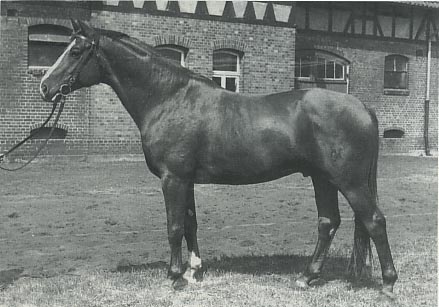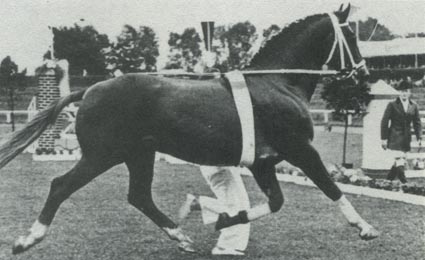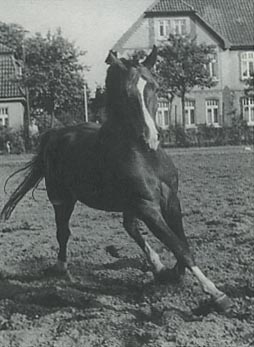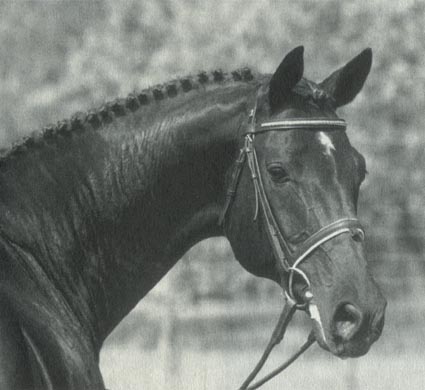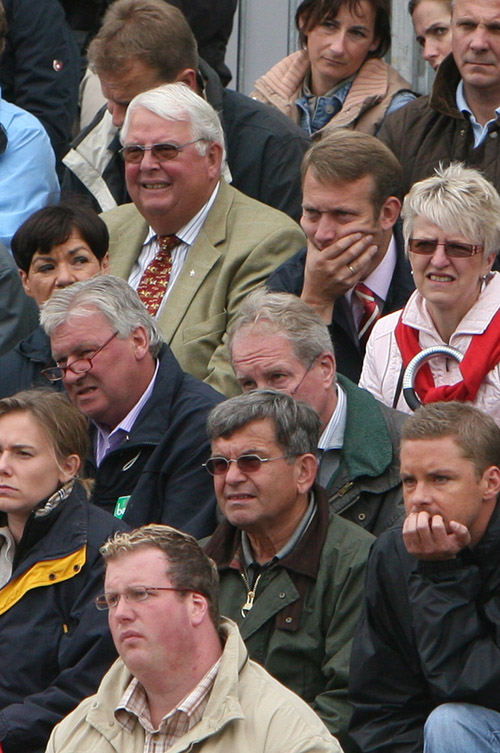When you came to CelIe 27 years ago, what was the breeders’ ideal type?
“I came to State Stud Celle in 1973 and from then to 1979, I was assistant to Dr von Stenglin. Since 1979, I have been the director of the stud. At the time I came to Celle, the change in the breeding of the riding horse, had already occurred. In earlier years, horses were bred for riding, as well as harness and agricultural or to work in the forest. Now we have to work more with Thoroughbred stallions, we have to select through the performance tests of the stallions – and the results of the progeny in competition. Riders – and the market – like horses that are very comfortable with good rideabilfty, high elasticity in the gaits, and I think because of the economy, the horses should be of good health, good conformation to last a long time in the sport because ft is very expensive to train the horse, and it is no economy to train a horse only to find that ft goes lame. That is our problem, to select and make the horses more comfortable for the riders. A special criteria for us is the interior of the horses, the ability to work with the rider, that’s a big problem, on this interior criteria, we have been very successful in the last 30-40 years – in the character, the temperament.”
By the word ‘interior’…?
“Exterior is the type and the gaits and so on. ‘lnterior’ is the character and temperament – the mind.”
Is it a problem that the majority of riders don’t want a world champion horse – those horses are probably too difficult to ride – yet the promotion of the Hanoverian horse depends on international success…
“We know that it is only a small fraction of riders who compete at the highest levels, and about 90% of the riders only ride in their free time, and they have less and less time to work with the horses, and they have less and less experience at working with horses – therefore we have to breed for good character, willingness and temperament We still need horses for the highest level for publicity for our association, but the priority has to be on the good temperament and character, and a comfortable feeling for the rider, and not the ability to score at the highest level.”
The Hanoverian Verband has not moved so strongly on the problem of OCD as the Dutch association which routinely x-rays stallion prospects?
“We have discussed all of these problems, but to take x-rays at the time of the stallion licensing is very difficult. The vets in Holland, Germany and the United States are not in agreement, it is not clear that this problem of OCD has a high heritabilfty – I think the influence of horse raising is very much higher than hereditary factors. There are different views amongst the vets, we can’t select on this basis until we are sure of the heritabilfty stage.”
“It’s the same with semen, in Holland they select on the basis of the semen quality of two and a half year old stallions. That’s crazy. They should wait one season. In Hannover, and in all the breeding associations in Germany, there are big discussions about xrays, but ft is not clear which way is correct.”
What have been the most influential stallions in your time at Celle?
“We must say that there has been a very big influence of the Trakehner horses, that and the selection of our broodmares. Our brood mares went from 34,000 in 1947, to 1960 when we had 4,000 broodmares, that is a big opportunity for selection, to get rid of the old types, and during that time we had the very good chance to use the Trakehner stallion, Abglanz and his son, Absalz and the grandsons, and grand-grandsons, they had a very big influence on the ‘type’ of the Hanoverian horse, and in riding quality as well – although in Hannover, I think we had good quality in riding horses before then, but to better the type, the Trakehner horses were very important. In Celle in 1949, there arrived 39 Trakehnen stallions from eastern Prussia. “
Absatz
“There were some very important stallions of the Hanoverian ‘C line – Gotthard, Grande, Goldfisch, Graphit the sons of Gotthard, but the most influence through this line was the sons of Grande. Then there was the influence of the ‘F line. The ‘F line has two branches: the one that was more for jumping with Ferdinand, Wendekreis, Wedekind. The other branch was Wohler, with World Cup, Weftrneyer, Wenzel, more for dressage.”
Wohler
We are also happy to have another old line springing up, the A’ line, now through Eiger, Esprit, Escudo.”
What was the influence of the ‘G’ line?
“As well for dressage as jumping. Big jumpers from Gotthard and Grande, and especially from Grande and his sons and grandsons, we have good dressage horses. Gotthard was only for jumpers”.
But if Grande came to the stallion licensing now…
“Oh, he wouldn’t be licensed. But that is the success of our breeding! At the time he was licensed, I believe there were discussions at that time even, because he was anything other than a riding horse, but he was of a good bloodline.”
Grande
Often in the history of various breeds of horse, there have been significant stallions that have been outsiders – they haven’t been bred right or they don’t look right – yet they have been hugely influential in their breeding Yet when you license stallions you must look to the standard type and then, do you run the risk of losing the genetic freak who can really influence the breed?
“That is a problem of our time – some stallions get no chance. We do a strong selection for the young stallions, each year for the state stud we test about 40 stallions and only keep about six or eight but the trouble is that all of those six or eight stallions don’t get the same chance, and some of them don’t get any chance at all because breeders talk and talk. In former limes the breeders had no chance to go by trailer for hundreds of kilometres, or order semen from here or there – they used the stallions that were sent to their district, and then several years later they could see which stallions were the best and often, it would be the stallion that they didn’t think was going to be the best and the one they thought was going to be best was not so good. Now there is not such an opportunity. If the stallion has a good performance test and we have good photographs, good coverage, and we push them, then the breeders will breed to that stallion – but we have lots of good stallions that don’t get that chance. Take the example of Duellant in his time nobody would take him. He went to the station at Landesbruk, as the second stallion no-one remembers the first stallion any more. After two or three years, Duellant was a champion, but I think that would be impossible now.”
When the breeders all used the stallions at their localstation, this produced very concentrated bloodlines in the local more band, and this made it easier for the head at Celle to select which stallion was needed in which area, but now the mares are by stallions from all over the breeding area ….
“That’s our problem now. In former limes it was easier to select stallions for each area, but we can’t go back.”
Is it the same with the mares, when we look at the mares of Dr Schulz-Stellenfleth, they are such an old fashioned type that they probably would not pass at a more show, yet those mares have bred such important ‘modem’ stallions as Wolkenstein II?
“Dr Schulz has a very good mother line, and as a consequence he is a very good breeder, he selects on the basis of bloodlines and heritability, and that is the success of this man. His mares are special types, short in the leg, small in the shoulder, but Dr Schulz has bred very good horses.”
Can the Hanoverian horses become too much like Thoroughbreds?
“I don’t think so, if the Thoroughbred is good enough they are very good horses.”
What is the next step in the evolution of the Hanoverian horse?
“To make better and better the riding ability we try to get the breeders to breed dressage mares to dressage stallions, and jumping mares to jumping stallions, but not to forget the riding ability in the jumping lines. The competition jumping riders say they like much better the jumpers with good riding ability. That’s a problem now, to improve the riding ability of the jumpers but not to lose the jumping talent.”
You had to make a policy to encourage the breeders to breed jumping horses because so many were concentrating on dressage?
“Some years ago, they founded the Hanoverian jumpers program, and since then we have lots of breeders who follow this program. Every year I buy forty or fifty colts for raising, and this year, it was very clear that there were lots of high quality offspring of jumpers, offered to me, much more than dressage talents. I think we have the time where we must run a dressage program (laughs). We have pushed and pushed to get the jumpers, now we must push the dressage line.”
The introduction of Anglo-Arab blood to Hannover has this been one of your initiatives?
“I had luck with Matcho, he was in my first years. It is as difficult to find good Anglo-Arabs as it is to find Thoroughbreds for breeding sport horses, it is a very special and very big problem. We have to test twenty stallions to get one who is a success in breeding riding horses.”
Matcho
“If you have a stallion like Matcho, or the Thoroughbred, Lauries Crusador, there is no problem to get mares for the stallions, but you only have a stallion like Matcho or Lauries Crusador every twenty years, but we have other stallions and no breeder will bring the mare to test the stallion. If you look at the photos of Der Lowe, or Pik As, very successful Thoroughbred stallions, but if I took such stallions to the breeding stations today, they would say ‘what’s wrong with you?’ It’s the same problem as with the stallions that have good performance tests, but are not winners of the performance test then they are not accepted. Matcho was high quality, very good shoulders, good saddle position, good frame, good conformation, and very good character and temperament also a very good walk and good riding ability. You find Matcho on the mother side of some very good horses. I think Lauries Crusador was the same, an exceptional Thoroughbred stallion with yery good offspring. We had some very good sons from him in the stud – Longchamp, Londonderry, Lancier, now on the mother side of some very good horses, you will find him. He was very good fortune for Hannover.”
It is only recently that you have brought into Hanoverian breeding two of the important modem stallions – Donnerhall and Rubinstein?
“It’s good to have the chance of other bloodlines. We have a lots of Weftmeyer, World Cup and so, so I think if we can buy a Rubinstein with a special mother line, and with Donnerhall, we have the chance to have a new influence of the old Hanoverian ‘D’ line. The ‘D’ line was very influential in former years with Duellant, DuIft and so, and the influence of this line is now lower than 5%. With Donnerhall we have the chance to have a new line. Both Rubinstein and Donnerhall are only for dressage horses. Rubinstein himself and the sons we have, Rotspon and Rosenthau, they have a lot of rideability – now we await the first sons. Last year I bought four sons of Rosenthau for raising. With Donnerhall I think he could do the same for us as Weftmeyer, but another bloodline.”
Are you prepared to take bloodlines from any where in Europe?
“If they are good enough. I travel kilometres on kilometres, because if someone rings up and offers me a Thoroughbred stallion, and if I don’t go – then some day I might regret it. Sometimes you can be lucky, when I bought Matcho it was only half an hour from the plane, I saw him at the racetrack and he looked out of his box, and I said, ‘that’s a good stallion, I would like to buy a stallion like that’ – then the boy opened the box, and lead Matcho out, and I bought him. It was a good day, ft was luck.”
With a really good stallion does that always happen, as you walk up to him, you know he is good?
“Mostly, if the first impression is good, then usually the horse is good. If you have to look and look and search for some positive points… With Lauries Crusador it was the same – anyone can see what an impressive horse he is.”
Is Holstein blood still important for you?
“Yes specially for jumping. There was a big influence from Calypso. I think he was the first stallion we brought into the Hanoverian studbook, now Calypso features on many mother lines, and they all tend to have very good jumping ability and good riding ability. Calypso II is a big very strong and heavy horse – we knew him from the performance test and when he was offered to me from the Holstein Association when he was about ten years old, I said ‘yes’. But when I offered him to the breeders, and I saw their faces! Such legs and such hooves!! I think 900 kilos weight They said, ‘oh well if you think ft is a good idea, we will try with him’. And they had very big success.”
You have never introduced Selle Français blood into Hannover?
“We tried but it is very difficult, because the Selle Français is a mixture – Anglo-Arabs, Draught horse – we might end up with foals with long hair on their legs. The other problem is that French breeders only look for jumping and they don’t look for riding ability. If you look at those horses, there is a very big problem in the mouth, and in the neck. We tried it, we had one Quasi Roi, I think he is a very good jumper with jumping offspring but our breeders when they go to see offspring they want to see movement, elasticity, foals they can sell. From the Selle Français they do not have the types you can sell as foals, perhaps you can sell them at five or six as good jumpers but that is a long way for normal breeders in our area.”
Now we see more and more private stallions standing in Hannover, is this competition for your State Stud?
“There are more privately owned stallions, some people who have good riders, then they compete the stallions and stand them at stud, then this is economically possible. But just to buy a stallion and stand him at your breeding station, that is a high risk. I think there are lots of people who think that might be nice, to buy two or three stallions and run a stud, but that is very difficult to do. There are some people – like Mr Pape, he is a good horseman and he has the possibility to ride his stallions – but for most it is very difficult work.”
You have made an arrangement that the State Stallion, Stakkato can be ridden in competition by Eva-Maria Bitter; will you follow the Westfalien example now and send more stallions out into competition?
“No, because you will not change a stallion in his heritabilfty by putting him in competition. Competition is public relations for the stud, but it is not a way to select stallions. I think it is very difficult to have a stallion in competition and also breeding. If you take semen on the Monday and look at the microscope, you can see by the quality of the semen if the horse has been competing at the weekend. The big problem with stallions in the sport is to have a good rider – and that means you must have a rider at the place the stallion does his breeding. In Celle, Mr Winter rides Escudo, or Glenfiddich, and Mr Witte, with Longchamp and it is not so far to train White Star, but it is difficult. With Stakkato, he is such a type that if I kept him as a stallion after the performance test he is such a type that I think the breeders would say ‘you can talk of his jumping ability but he is not our type’ but after Eva-Maria Bitter competes with him, then the breeders want to use him – so every year I have about 100 mares which is good for the stallion, but if I hadn’t done that with Stakkato, then maybe he would never have had his chance.”
Now we will wait and see if his offspring are as good as we think they are… “
Is the Bundeschampionate becoming more and more important?
“Sure, but there is only one Bundeschampion each year. I think only the first is the winner, no one talks about the second horse. When we have a good horse, we try, but the priority for us is breeding – select, and go the correct way, to work with the breeders and try to give all the stallions the opportunity to show us their progeny.”
Is size important?
“No. Yes we have to measure them but you can have a big small horse, and you can have a small big horse. The horse must have a special frame, and become bigger in the movement. The minimum is 163 or 164 cms when they are three and a haIf, but years ago it had to be 165 at two and a half – that’s crazy, you have to see the horse as a whole, not just the size.”
If you are looking at a group of young horses is it easy to make a selection?
“I am in the lucky position that I have very good people around me in the Stud, at all the stations, and the tell me about good colts, then I buy them.”
How much can you see in a foal?
“I think you can see quite a lot If after two years raising you have a ratio of 20-30% of the foals you buy that you want to keep, then you have done very well.”
For all Dr Bade can look a forbidding figure in his bowler hat and overcoat in the middle of the judging ring when you meet him in person, he is in fact a warm, witty individual, and we thank him for taking the time out of his busy schedule for this interview…
This article first appeared in the October 2000 edition of The Horse Magazine



